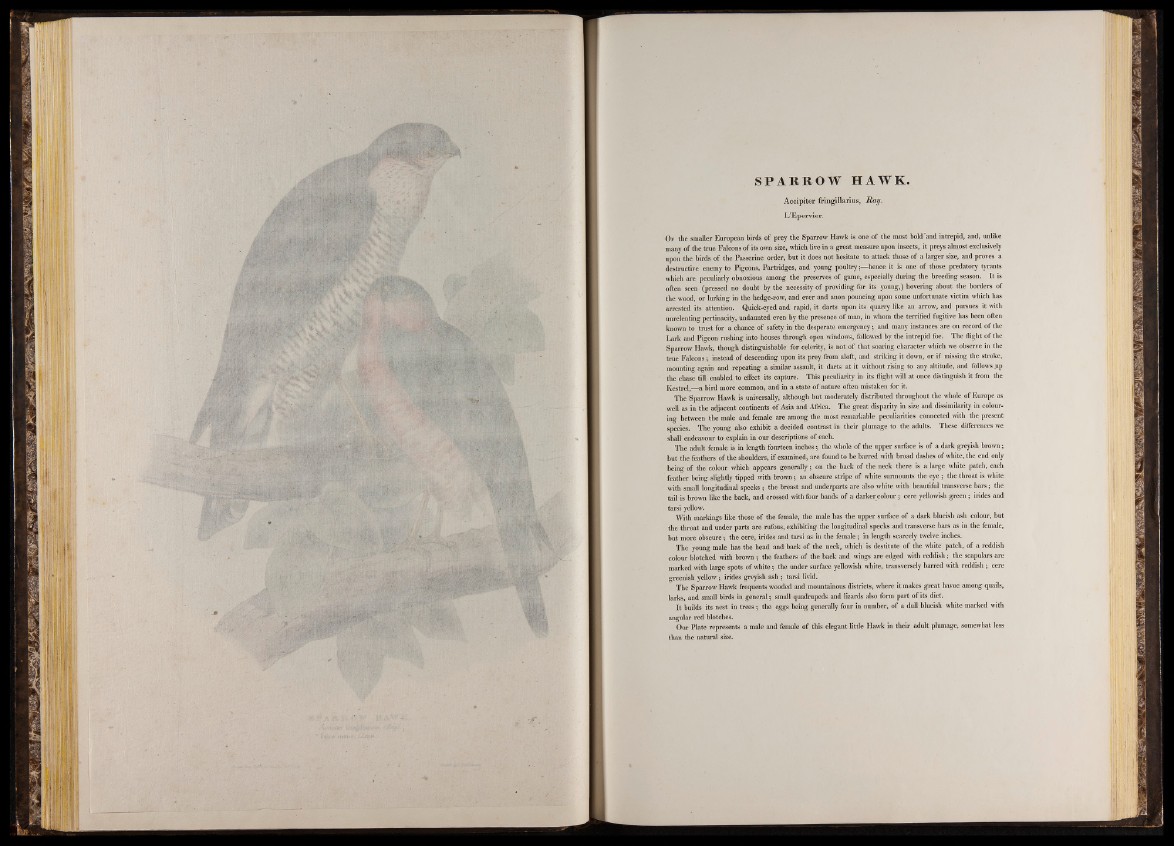
■
S P A R R OW HAWK.
Accipiter fringillarius, R a y .
L’Epervier.
Of the smaller European birds of prey the Sparrow Hawk is one of the most bold and intrepid, and, unlike
many of the true Falcons of its own size, which live in a great measure upon insects, it preys almost exclusively
upon the birds of the Passerine order, but it does not hesitate to attack those of a larger size, and proves a
destructive enemy to Pigeons, Partridges, and young poultry;—hence it is one of those predatory tyrants
which are peculiarly obnoxious among the preserves of game, especially during the breeding season. It is
often seen (pressed no doubt by the necessity of providing for its young,) hovering about the borders of
the wood, or lurking in the hedge-row, and ever and anon pouncing upon some unfortunate victim which has
arrested its attention. Quick-eyed and rapid, it darts upon its quarry like an arrow, and pursues it with
unrelenting pertinacity, undaunted even by the presence of man, in whom the terrified fugitive has been often
known to trust for a chance of safety in the desperate emergency; and many instances are on record of the
Lark and Pigeon rushing into houses through open windows, followed by the intrepid foe. The flight of the
Sparrow Hawk, though distinguishable for celerity, is not of that soaring character which we observe in the
true Falcons; instead of descending upon its prey from aloft, and striking it down, or if missing the stroke,
mounting again and repeating a similar assault, it darts at it without rising to any altitude, and follows .up
the chase till enabled to effect its capture. This peculiarity in its flight will at once distinguish it from the
Kestrel,—a bird more common, and in a state of nature often mistaken for it.
The Sparrow Hawk is universally, although but moderately distributed throughout the whole of Europe as
well as in the adjacent continents of Asia and Africa. The great disparity in size and dissimilarity in colouring
between the male and female are among the most remarkable peculiarities connected with the present
species. The young also exhibit a decided contrast in their plumage to the adults. These differences we
shall endeavour to explain in our descriptions of each.
The adult female is in length' fourteen inches; the whole of the upper surface is of a dark greyish brown;
but the feathers of the shoulders, if examined, are found to be barred with broad dashes of white, the end only
being of the colour which appears generally; on the back of the neck there is a large white patch, each
feather being slightly tipped with brown; an obscure stripe of white surmounts the eye ; the throat is white
with small longitudinal specks ; the breast and underparts are also white with beautiful transverse bars; the
tail is brown like the back, and crossed with four bands of a darker colour; cere yellowish green; irides and
tarsi yellow.
With markings like those of the female, the male has the upper surface of a dark blueish ash colour, but
the throat and under parts are rufous, exhibiting the longitudinal specks and transverse bars as in the female,
but more obscure; the cere, irides and tarsi as in the female; in length scarcely twelve inches.
The young male has the head and back of the neck, which is destitute of the white patch, of a reddish
colour blotched with brown ; the feathers of the back and wings are edged with reddish; the scapulars are
marked with large spots of white; the under surface yellowish white, transversely barred with reddish ; cere
greenish yellow ; irides greyish ash ; tarsi livid.
The Sparrow Hawk frequents wooded and mountainous districts, where it makes great havoc among quails,
larks, and small birds in general; small quadrupeds and lizards also form part of its diet.
It builds its nest in trees; the eggs being generally four in number, of a dull blueish white marked with
angular red blotches.
Our Plate represents a male and female of this elegant little Hawk in their adult plumage, somewhat less
than the natural size.